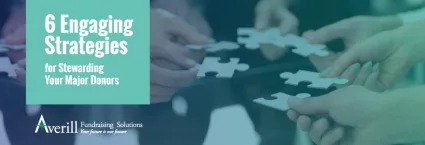
Fundraising is the bread and butter of the nonprofit world. Consequently, your nonprofit invests a lot of time, energy, and money into its fundraising efforts. So, whether you’re hosting your annual gala, selling t-shirts, setting up a community fun run, or preparing for a text-to-give campaign, you want to do everything you can to ensure that none of your team’s hard work goes to waste.
You can do a decent job of judging your success simply by evaluating your campaigns’ ROI or trying to gauge your supporters’ moods as they leave an event. But to really know whether your fundraising efforts are sticking the landing with your supporters, you’ll need to get to know them.
Of course, you likely already know a lot about your donors, and you may even know some of them personally. But taking a more deliberate approach to understanding your donors using thorough prospect research (also known as donor research) is a critical element of an effective fundraising strategy, especially when it comes to securing gifts from major donors.
In this post, we’ll help you get started by offering four quick tips for conducting effective prospect research:
- Understand what you’re looking for.
- Leverage the right tools.
- Work with a prospect research consultant.
- Put your research to good use.
Comprehensive prospect research can make all the difference in how your nonprofit connects with your community, secures support, and delivers your mission to your beneficiaries. Let’s jump right into our four tips.
1. Understand what you’re looking for.
According to Donorly, prospect research is “the process of identifying potential major donors for your nonprofit, helping you take a more focused approach to secure major gifts, capital campaign contributions, planned gifts, and more.”
When you conduct prospect research, you’ll be looking for both capacity (wealth) and affinity (warmth) markers. These markers let you know that a donor is in a financial position to give a large donation and has a personal interest in or connection to your mission.
Here are some examples of typical capacity markers:
- Real estate ownership
- Stock holdings
- Business affiliations
And here are a few examples of affinity markers:
- Political affiliations and past donations
- Donation history and previous involvement with your organization or similar organizations
- Connections with current donors in your CRM
- Demographics and other personal information
But what might these affinity and capacity markers look like in the real world?
Say you discover a new prospect named Taylor. You find that Taylor owns a lot of real estate and has high-end business affiliations. Both these markers indicate she may have the financial ability to give a large gift. On top of that, you look back at records of event attendance and notice that Taylor has attended a few of your nonprofit’s webinars. She also seems to run in the same social circles as many of your current major donors.
With this information, your nonprofit’s major gifts officer or development team can be empowered to reach out and begin cultivating a relationship with Taylor!
2. Leverage the right tools.
Just as you want the right fundraising tools on your side for an effective campaign, you’ll need the right tools and resources for effective prospect research. These tools will help you collect and analyze information about prospects, allowing you to identify capacity and affinity markers and giving you the contact information and talking points you need to begin reaching out to prospects.
Here are a few common prospecting tools you’ll need in your toolbox:
- Your nonprofit’s CRM: Start with your internal donor data. Not only can your CRM reveal important trends about major giving in your organization, but you can also identify existing relationships between your prospects and current donors. For example, you might identify family, work, or academic connections.
- Government records: SEC investment records and political contribution information from the FEC can help you learn more about a prospect’s financial capacity to give.
- Matching gift database: According to Double the Donation’s rundown of matching gift software vendors, matching gifts represent a major opportunity to score more revenue for your organization. But it can be time-consuming to research prospects’ employers and their corporate giving programs. A matching gift database empowers new (and existing) donors to learn about their employers’ programs and submit their gift matching information on their own.
- Prospect generator tools: A prospect generator grants you access to lists of other organizations’ donors. Typically, these organizations will have a similar mission to your own, so you can infer affinity when you discover a prospect.
You may be thinking, “Our nonprofit currently doesn’t have the bandwidth to dedicate to learning how to use these tools and conduct donor research on its own.” This is a common roadblock for many organizations, especially newer or smaller nonprofits. Let’s take a closer look at how you can overcome this obstacle by tapping into the expertise of a third-party expert.
3. Work with a prospect research consultant.
If your nonprofit isn’t in a spot where a major gifts officer or development team can take on the demands of prospect research, consider working with a nonprofit consultant that specializes in prospect research.
Prospect research consultants understand how to leverage prospecting tools most effectively to gather and analyze useful information. They’ll also take your research efforts a step further and help you determine how to use your research to advance your nonprofit’s fundraising strategy.
As you begin researching potential consultants to work with, keep these five factors in mind:
- The scope of your needs. Are you looking for prospecting guidance ahead of a specific campaign, like a capital campaign? Or does your organization just want to strengthen its major giving program in general? Consider what your nonprofit needs from working with a consultant. You’ll have the opportunity to communicate your needs to potential consultants in a request for proposal (RFP).
- Your nonprofit’s time and location requirements. Determine how much time your team needs with your prospect research consultant—are you looking for a one-time engagement or continuous support? Also, consider whether you’re willing to work with a consultant remotely or if you want to hire a local consultant who you can meet with in person.
- The consultants’ track records. Before signing a contract with a consultant, it’s important to know whether they have a history of delivering great work. Don’t be afraid to ask the consultants you’re considering for samples of previous work or references. And, if you know someone who has worked with the consultant before, be sure to reach out and get feedback from them.
- Your nonprofit’s budget. Like any nonprofit endeavor, budget will be a major consideration when it comes to working with a nonprofit consultant. Make sure your entire team—including your executive director and board of directors—is on the same page when it comes to expectations for working with a consultant and the amount of money you’re willing to use to do so. You should also make sure you clearly understand the consultants’ pricing model.
- Your organization’s internal culture. The best consultants will fit well into your organization’s culture. They should provide you with guidance and direction that works seamlessly with your mission and goals instead of taking the reins and forcing their own vision on your team. Look for someone who is interested in your work and who is willing to workshop their ideas.
Since working with a consultant will be an investment for your nonprofit, it’s worth taking the time to ensure you’ve found the right fit. Consider each of these five factors as you conduct a careful hiring process.
4. Put your research to good use.
Once you have a list of prospects to reach out to, you can begin taking action! Use the information you have to connect with them and begin building relationships. Like any relationship, this will likely start with an initial getting-to-know-you conversation. You might inquire about the prospect’s career, their family, or their previous experiences supporting nonprofit work. Don’t be afraid to turn the data you’ve gathered into talking points to get you started off on the right foot!
From there, your donor cultivation efforts will require a lot of patience and time. After all, building a rapport and establishing mutual trust doesn’t happen overnight. Take your time and remember these tips:
- Be genuine.
- Reach out frequently.
- Don’t ask for a donation too soon.
- Offer multiple opportunities to get involved with your cause.
Like any donors, your new prospective donors want to feel seen as people, not ATMs. As you make an effort to build genuine relationships with prospects, you’ll be laying the foundation for future giving and long-lasting connections with your nonprofit.
Prospect research is a challenging process that requires your nonprofit team to think beyond its current fundraising capacity and envision a bright future of new relationships and an expanded donor community.
As you follow these tips for conducting effective prospect research, you’ll be better able to approach the process with confidence. And someday soon, you’ll be on the other side of the prospect research journey, thanking a new donor for a major donation! Good luck!

Guest Author – Founder and President Sandra Davis leads Donorly with 30 years of fundraising experience and leadership. Sandra has consulted on numerous capital campaigns, led strategic planning and feasibility study efforts, and managed board development and recruitment efforts, planned giving, special events, and annual giving programs. Under her leadership, Donorly has grown to support the fundraising efforts of over 75 clients to date.



